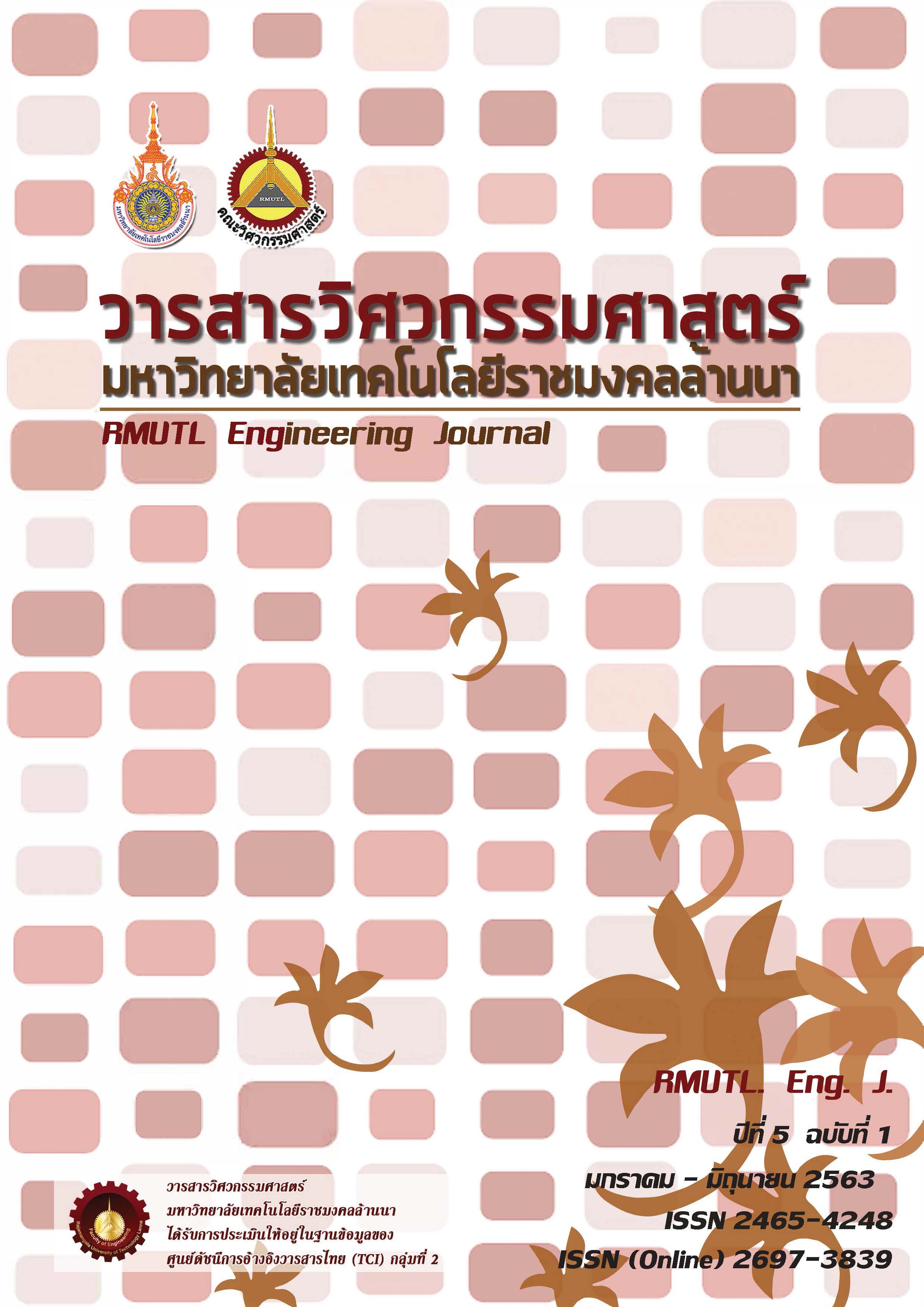Chicken Slaughterhouse Wastewater Characteristics, Current Treatment and Future Challenges: A review
DOI:
https://doi.org/10.14456/rmutlengj.2020.6Keywords:
Chicken slaughterhouse wastewater, wastewater characteristics, wastewater treatmentAbstract
In this study, a thorough review of advancement in chicken slaughterhouse wastewater (CSWW) characteristics, current treatment and future challenges were presented. The data of CSWW characteristics and discharge limits were collected, in particular in Thailand, as well as in several other neighboring countries and the world’s leading chicken meat producing countries. The data clearly showed that the CSWW typically contained high concentrations of organic matter in the forms of Biochemical Oxygen Demand and Chemical Oxygen Demand, suspended solids, oil and grease, and nitrogen in the form of Total Kjeldahl Nitrogen. For example, in Thailand the concentrations of mentioned parameters were ranged from 490-1200 mg/L, 890-1900 mg/L, 415-700 mg/L, 80-190 mg/L and 73-240 mg/L, respectively. In the treatment of CSWW, biological wastewater treatment was commonly applied for the removal of organic matter and nutrients. An overview of the typical CSWW treatment systems was also discussed. Moreover, this review also provided a better understanding of the future challenges of CSWW management that aimed at both high treatment efficiency and potential resource recovery.
References
2.Shahbandeh M. Global meat industry - statistics & facts. Available from: https://www.statista. com/topics/4880/global-meat-industry/#dossie rSummary__chapter1 [Accessed 7th April 2020].
3.Njoya M, Basitere M, Ntwampe SK. Analysis of the characteristics of poultry slaughterhouse wastewater (PSW) and its treatability. Water Practice & Technology. 2019;14(4):959-970.
4.Department of Livestock Development and National Institute of Development Administration. Strategy for the department of livestock development during the period of 2018-2022. Ministry of Agriculture and Cooperatives, Bangkok, Thailand;2018.Thai.
5.Natthaporn O. The guidelines for improving quality of wastewater from chicken slaughter industry for water reuse. Master thesis. King Mongkut's University of Technology Thonburi, Bangkok; 2014.Thai.
6.Department of Industrial Works, Thailand. Chapter 1: Knowledge of the chicken slaughtering and processing industries. In: Regulatory handbook for the chicken slaughtering and processing industries. Ministry of Industry, Bangkok, Thailand;2010.Thai.
7.Avula RY, Nelson HM, Singh RK. Recycling of poultry process wastewater by ultrafiltration. Innovative Food Science & Emerging Technologies. 2009;10(1):1-8.
8.Yaakob MA, Mohamed RMSR, Al-Gheethi AAS, Kassim AHM. Characteristics of chicken slaughterhouse wastewater. Chemical Engineering Transactions. 2018;63:637-42.
9.Bustillo-Lecompte C, Mehrvar M. Chapter 8 Slaughterhouse wastewater: Treatment, management and resource recovery. Physico-chemical wastewater treatment and resource recovery. 2017:153-74.
10.Daud NNN, Anijiofor SC. Chicken slaughterhouse wastewater disposal: The challenges ahead. Asian Journal of Agriculture and Biology. 2018;
(Special Issue):42-5.
11.Pereira EB, De Castro HF, Spiller VR, Junior AF. Degradation of fat and grease in slaughterhouse wastewater by a commercial microbial lipase. Brazilian Archives of Biology and Technology. 2006;49:21-8.
12.USEPA. Technical development document for the final effluent limitations guidelines and standards for the meat and poultry products point source category (40 CFR 432). Washington DC, USA: United States Environmental Protection Agency;2004.
13.Wu PF, Mittal GS. Characterization of provincially inspected slaughterhouse wastewater in Ontario, Canada. Canadian Biosystems Engineering. 2012;54:9-18.
14.COWI Consulting Engineers and Planners AS, Denmark. Cleaner production assessment in meat processing. United Nations Environment Programme, Division of Technology, Industry and Economics, and Danish Environmental Protection Agency, Copenhagen, Denmark; 2000.
15.APHA. Standard methods for the examination of water and wastewater. 22nd eds. American Water Works Association and Water Environment Federation. Washington DC, USA;2012.
16.Prachuab T. Appropriate waste water management systems for chicken slaughter houses. Master thesis. King Mongkut’s University of Technology North Bangkok, Bangkok; 1999.Thai.
17.Prasith R. How to manage wastewater in food Industry: Plenary session of the International Conference of Thai Water 2013: Water for the future, June 6-7, 2013, Bangkok, Thailand; 2013.Thai.
18.Kwannate M. Study of the efficiency of granular activated carbon - sequencing batch reactor (GAC-SBR) for treating slaughterhouse wastewater. Master thesis. King Mongkut’s University of Technology Thonburi, Bangkok; 2000.Thai.
19.CMS Environmental Consultant. The study of high polluting industries for the reduction of pollution: Poultry slaughterhouse industry. CMS Engineering & Management Co., Ltd. Bangkok, Thailand;1995. p.5-30.
20.Ministry of Industry, Thailand. Notification of Ministry of Industry regarding industrial effluent standards B.E. 2560. Issued on 30th May B.E. 2560. Royal Thai Government Gazette;2017.
21.Seswoya RB, Mat Daud AM, Md Ali Z, Mohamed Basri ZDB, Raja Yunus RNB. The first attempt of chicken wastewater treatment using sand filtration. In: International Conference on Science and Technology Application in Industry & Education (ICSTIE'06), 8-9 December 2006, Universiti Teknologi MARA (UiTM), Penang, Malaysia; 2006.
22.Bakar JA, Mohamed RMSR, Bakar M, Baker R, Al-Gheethi AAS, Fitriani N. Small-scale chicken slaughterhouse industries: Production and its effluent quality characteristics. Pollution Research. 2019;August Suppl. Issue:S43-8.
23.Oktafani B, Siami L, Hadisoebroto R, Tazkiaturrizki T, Ratnaningsih R. The effect of aeration time on chicken slaughterhouse water treatment using GAS-SBR. Journal of Physics: Conference Series. IOP Publishing. 2019;1402(3):1-6.
24.Chen XM, Zhang P, Wang HY, Yu S, Deng L, Yu XG. Technical process adopting DAT-IAT (demand aeration tank-intermittent aeration tank) for livestock and poultry slaughter wastewater treatment. CN102887586A (Patent) 2012.
25.NCLEAR. TPX™ helps solve wastewater challenges in poultry processing. Georgia, USA: NCLEAR Inc.; 2019. Available from: https://nclear.us/wp-content/uploads/2020/02 /Fieldale-Farms-Case-Study-Draft-Final-CH.pdf [Accessed 7th April 2020].
26.Sardari K., Askegaard J, Chiao, YH, Darvishmanesh S, Kamaz M, Wickramasinghe SR. Electrocoagulation followed by ultrafiltration for treating poultry processing wastewater. Journal of Environmental Chemical Engineering. 2018;6(4):4937-44.
27.Kiepper BH. Effects of tertiary microsieving on the composition of poultry processing wastewater. Journal of Applied Poultry Research. 2009;18(4):716-24.
28.Del Nery V, Damianovic MHZ, Moura RB, Pozzi E, Pires EC, Foresti E. Poultry slaughterhouse wastewater treatment plant for high quality effluent. Water Science and Technology. 2016;
73(2);309-16.
29.Del Nery V, De Nardi IR, Damianovic MHRZ, Pozzi E, Amorim AKB, and Zaiat M. Long-term operating performance of a poultry slaughterhouse wastewater treatment plant. Resources, Conservation and Recycling. 2007;50(1):102-14.
30.Bustillo-Lecompte C, Mehrvar M, Quinones-Bolanos E. Slaughterhouse wastewater characterization and treatment: An economic and public health necessity of the meat processing industry in Ontario, Canada. Journal of Geoscience and Environmental Protection. 2016;4(4):175-86.
31.The Ministry of Environment, British Columbia. Technical guidance document for the slaughter and poultry processing industries. Victoria, Canada, Environmental Protection Division;
2018.
32.Basitere M, Rinquest Z, Njoya M, Sheldon MS, Ntwampe SK. Treatment of poultry slaughterhouse wastewater using a static granular bed reactor (SGBR) coupled with ultrafiltration (UF) membrane system. Water Science and Technology. 2017;76(1):106-14.
33.Basitere M, Njoya M, Rinquest Z, Ntwampe SK., Sheldon MS. Performance evaluation and kinetic parameter analysis for static granular bed reactor (SGBR) for treating poultry slaughterhouse wastewater at mesophilic condition. Water Practice and Technology. 2019;14(2):259-68.
34.Department of Water and Sanitation, South Africa. Department of Water and Sanitation notice 1154 of 2015, No. 39411. Issued on 13th November 2015. Pretoria, South Africa Government Gazette;2015.
35.Rajakumar R, Meenambal T, Banu JR, Yeom IT. Treatment of poultry slaughterhouse wastewater in upflow anaerobic filter under low upflow velocity. International Journal of Environmental Science & Technology. 2011;8(1):149-58.
36.Chavez CP, Castillo RL, Dendooven L., Escamilla-Silva EM. Poultry slaughter wastewater treatment with an up-flow anaerobic sludge blanket (UASB) reactor. Bioresource technology. 2005;96(15):1730-36.
37.Mexico Secretary of Environment, Natural Resources and Fisheries. Mexican Official Standard: NOM-001-ECOL-1996: Pollutants in wastewater discharges into national waters and goods. Issued on 24th June 1996. Mexico Official Journal of the Federation. Available from: http://cepis.org.pe/mexican-official-stan dard-001ecol1996/ [Accessed 20th April 2020].
38.Bayar S, Yildiz YS, Yilmaz AE, Irdemez S. The effect of stirring speed and current density on removal efficiency of poultry slaughterhouse wastewater by electrocoagulation method. Desalination. 2011;280(1-3):103-7.
39.Republic of Turkey Ministry of Environment and Forest. Water pollution and control regulations, Issue 25687. Issued on 31st December 2004. Ankara, Turkey Official Gazette;2004.
40.Yordanov D. Preliminary study of the efficiency of ultrafiltration treatment of poultry slaughterhouse wastewater. Bulgarian Journal of Agricultural Science. 2010;16(6):700-4.
41.Metcalf and Eddy. Wastewater engineering: Treatment and reuse. International edition 4 th ed. USA: McGraw-Hill;2004.
42.Williams Y. Treatment of poultry slaughterhouse wastewater using an expanded granular sludge bed anaerobic digester coupled with anoxic/aerobic hybrid side stream ultrafiltration membrane bioreactor. PhD thesis. Cape Peninsula University of Technology, Cape Town, South Africa; 2017.
43.Baker BR, Mohamed R, Al-Gheethi A., Aziz HA. Advanced technologies for poultry slaughterhouse wastewater treatment: A systematic review. Journal of Dispersion Science and Technology. 2020:1-20.
44.Pozo RD, Tas DO, Dulkadiroglu H, Orhon D, Diez V. Biodegradability of slaughterhouse wastewater with high blood content under anaerobic and aerobic conditions. Journal of Chemical Technology & Biotechnology. 2003;78(4):384-91.
45.Kiepper BH. Characterization of poultry processing operations, wastewater generation, and wastewater treatment using mail survey and nutrient discharge monitoring methods. Master thesis. The University of Georgia, USA; 2003.
46.Peng, G. Inter-organizational information exchange, supply chain compliance and performance. PhD thesis. Wageningen University, Wageningen, The Netherlands; 2011.
47.Bingo MN, Basitere M, Ntwampe SKO. Poultry slaughterhouse wastewater treatment plant design advancements. Conference papers of the 16th SOUTH AFRICA Int'l Conference on Agricultural, Chemical, Biological & Environmental Sciences (ACBES-19), November 18-19, 2019, Johannesburg, South Africa; 2019.
48.Dlamini DN, Basitere M., Ntwampe SKO. Current and functional reactor designs in poultry slaughterhouse wastewater treatment. Conference papers of the 16th SOUTH AFRICA Int'l Conference on Agricultural, Chemical, Biological & Environmental Sciences (ACBES-19), November 18-19, 2019, Johannesburg, South Africa; 2019.
49.Molapo NA. Waste handling practices in the South African high-throughput poultry abattoirs. PhD thesis. Central University of Technology, Free State; 2009.
50.Aziz HA, Puat NNA, Alazaiza MYD, Hung YT. Poultry slaughterhouse wastewater treatment using submerged fibers in an attached growth sequential batch reactor. International Journal of Environmental Research and Public Health. 2018;15(8),1734:1-12.
51.Masoumi Z, Shokoohi R, Atashzaban Z, Ghobadi N, Rahmani AR. Stabilization of excess sludge from poultry slaughterhouse wastewater treatment plant by the fenton process. Avicenna Journal of Environmental Health Engineering. 2017;2(1),e3239:1-5.
52.Khiewwijit R, Temmink H, Rijnaarts H, Keesman KJ. Energy and nutrient recovery for municipal wastewater treatment: how to design a feasible plant layout?. Environmental Modelling & Software. 2015;68:156-65.
53.Chernicharo CD. Post-treatment options for the anaerobic treatment of domestic wastewater. Reviews in Environmental Science and Bio/Technology. 2006;5(1):73-92.
54.Cook EAJ, de Glanville WA, Thomas LF, Kariuki S, de Clare Bronsvoort BM, Fevre EM. Working conditions and public health risks in slaughterhouses in western Kenya. BMC Public Health. 2017;17(1),14:1-12.
55.Martin EJ, Martin ET. Technologies for small water and wastewater systems. New YorK, USA: Van Nostrand Reinhold;1991.
56.Kobya M, Senturk E, Bayramoglu M. Treatment of poultry slaughterhouse wastewaters by electrocoagulation. Journal of hazardous materials. 2006;133(1-3):172-6.
57.USEPA. Wastewater technology fact sheet anaerobic lagoons. Washington DC, USA: United States Environmental Protection Agency;2002.
58.Debik E, Coskun TJBT. Use of the Static Granular Bed Reactor (SGBR) with anaerobic sludge to treat poultry slaughterhouse wastewater and kinetic modeling. Bioresource Technology. 2009;100(11):2777-82.
59.Basitere M, Williams Y, Sheldon MS, Ntwampe SKO, De Jager D, Dlangamandla C. Performance of an expanded granular sludge bed (EGSB) reactor coupled with anoxic and aerobic bioreactors for treating poultry slaughterhouse wastewater. Water Practice and Technology. 2016;11(1):86-92.
60.Affes M, Aloui F, Hadrich F, Loukil S, Sayadi S. Effect of bacterial lipase on anaerobic co-digestion of slaughterhouse wastewater and grease in batch condition and continuous fixed-bed reactor. Lipids in Health and Disease. 2017;16(1),195:1-8.
61.Ogejo JA, Li L. Enhancing biomethane production from flush dairy manure with turkey processing wastewater. Applied Energy. 2010;
87(10):3171-77.
62.Foucault LJ. Anaerobic co-digestion of chicken processing wastewater and crude glycerol from biodiesel. Master thesis. Texas A & M University, USA; 2011.
63.Cuetos MJ, Gomez X, Martinez EJ, Fierro J, Otero M. Feasibility of anaerobic co-digestion of poultry blood with maize residues. Bioresource Technology. 2013;144:513-20.
64.Latifi P, Karrabi M, Danesh S. Anaerobic co-digestion of poultry slaughterhouse wastes with sewage sludge in batch-mode bioreactors (effect of inoculum-substrate ratio and total solids). Renewable and Sustainable Energy Reviews. 2019;107:288-96.
65.Kuruti K., Nakkasunchi S, Begum S, Juntupally S, Arelli V, Anupoju GR. Rapid generation of volatile fatty acids (VFA) through anaerobic acidification of livestock organic waste at low hydraulic residence time (HRT). Bioresource Technology. 2017;238:188-93.
66.Placido J, Zhang Y. Production of volatile fatty acids from slaughterhouse blood by mixed-culture fermentation. Biomass Conversion and Biorefinery. 2018;8(3):621-34.
67.Khiewwijit R, Temmink H, Labanda A, Rijnaarts H, Keesman KJ. Production of volatile fatty acids from sewage organic matter by combined bioflocculation and alkaline fermentation. Bioresource Technology. 2015;197:295-301.
68.Da Costa PM, Vaz-Pires P, Bernardo F. Antimicrobial resistance in Escherichia coli isolated in wastewater and sludge from poultry slaughterhouse wastewater plants. Journal of Environmental Health. 2008;70(7):40-5.










